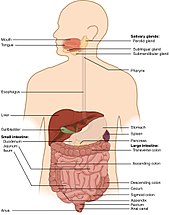Auto-brewery syndrome
| Auto-brewery syndrome | |
|---|---|
| Other names | Gut fermentation syndrome, Endogenous ethanol fermentation |
 | |
| Digestive system | |
Auto-brewery syndrome (ABS) (also known as gut fermentation syndrome, endogenous ethanol fermentation or drunkenness disease) is a condition characterized by the fermentation of ingested carbohydrates in the gastrointestinal tract of the body caused by bacteria or fungi.
Researchers speculate the underlying causes of ABS are related to prolonged antibiotic use,[5] poor nutrition and/or diets high in carbohydrates,[6] and to pre-existing conditions such as diabetes and genetic variations that result in improper liver enzyme activity.[7] In the last case, decreased activity of aldehyde dehydrogenase can result in accumulation of ethanol in the gut, leading to fermentation.[7] Any of these conditions, alone or in combination, could cause ABS, and result in dysbiosis of the microbiome.[5]
Another variant, urinary auto-brewery syndrome, is when the fermentation occurs in the urinary bladder rather than the gut.
Claims of endogenous fermentation have been attempted as a defense against drunk driving charges, some of which have been successful, but the condition is so rare and under-researched they are currently not substantiated by available studies.[7]
Symptoms and signs
This disease can have profound effects on everyday life. Symptoms that usually accompany ABS include elevated blood alcohol levels as well as symptoms consistent with alcohol intoxication—such as slurred speech, stumbling, loss of motor functions, dizziness, and belching.[8] Mood changes and other neurological problems have also been reported.[1] Several cases in the United States and one in Belgium have argued endogenous fermentation as a defense against drunk driving.[7][9]
Risk factors
Certain clinical conditions such as
Kaji et al. noticed a correlation between this syndrome and previous abdominal surgeries and disturbances, such as a dilation of the duodenum. Stagnation of the contents ensues, which favors proliferation of the causative organisms.[8]
Gut fermentation syndrome has been investigated, but eliminated, as a possible cause of
Metabolic action

Diagnosis
Alcohol levels within the body are usually detected through blood or breath. The best way to identify endogenous ethanol in the bloodstream is through gas chromatography. In gas chromatography the breath or blood is heated so that the different components of the vapor or blood separate. The volatile compounds then pass through a chromatograph that isolates ethanol from the other volatiles so that it can be quantified.[14]
More convenient methods include serum measurements and breathalyzers, especially during an acute attack at home.
In diagnosing ABS through serum measurement methods, patients must fast in order that baseline blood alcohol and blood glucose levels can be established. They are then administered a dose of IG glucose to see if there is an increase in blood alcohol as well as blood sugar.[15] Blood glucose level can be measured with enzyme-amperometric biosensors, as well as with urine test strips.[16] Many of these tests are performed in combination to rule out lab mistakes and alcohol ingestion so that the syndrome is not misdiagnosed.[10]
Treatment
First, patients diagnosed with ABS are treated for the immediate symptoms of alcohol intoxication.[1] Next, patients can take medications if they test positive for the types of fungi or bacteria that cause gut fermentation. For example, antifungals such as fluconazole or micafungin can be prescribed by a physician.[8][6][17] Often, probiotics are given concurrently to ensure that the proper bacteria recolonize the gut, and to prevent recolonization by the microorganisms that caused the syndrome.[17] Patients also typically undergo a diet therapy where they are placed on a high protein, low carbohydrate diet to avoid the symptoms of ABS.[1] The treatments listed above can be used individually or in combination to reduce the effects of the syndrome.[1]
Case studies
- In 2019, a 25-year-old man presented with symptoms consistent with alcohol intoxication, including dizziness, slurred speech and nausea. He had no prior alcoholic drinks but had a blood alcohol level of 0.3 g/dL. The patient was given 100 mg of the antifungal fluconazole daily for 3 weeks, and his symptoms were resolved.[8]
- In 2004, a 44-year-old male was treated with the antibiotics clavulanic acid and amoxicillin for an unrelated condition. Eight days after being discharged, he returned to the emergency room with abdominal pain and belching and was in a state of confusion. An esophagogastroscopy showed the presence of S. cerevisiae and C. albicans in his gastric fluid, causing endogenous ethanol production.[18]
- Reported in 2001, a 13-year-old girl with short gut syndrome suddenly developed symptoms of intoxication after eating "excess carbohydrates and juices". She had no access to alcohol any time the symptoms were present. Her small intestine was colonized by two organisms: C. glabrata and S. cerevisiae. She was treated with fluconazole and her symptoms resolved.[19]
- A case of urinary fermentation of carbohydrates by endogenous microorganisms leading to urinary ethanol has been reported. This single reported case is associated with diabetes due to the presence of sugar in the urine for the yeast to ferment. The person did not develop symptoms of intoxication, but did test positive in the urine for alcohol. Fermentation may continue after the urine is expressed, resulting in it developing an odor resembling wine.[20][21]
References
- ^ PMID 30020718. Retrieved 2020-04-26.
- PMID 6520589.
- ISSN 1595-689X.
- ^ S2CID 3666503.
- ^ PMID 31037230.
- ^ PMID 31777691.
- ^ S2CID 6926029.
- ^ PMID 31750376.
- ^ "2 promille alcohol in zijn bloed, maar toch vrijgesproken voor rijden onder invloed: man uit Brugge lijdt aan autobrouwerijsyndroom". VRT (in Dutch). 22 April 2024. Retrieved 23 April 2024.
- ^ PMID 31543403.
- S2CID 29917601.
- ^ OCLC 1054599976.)
{{cite book}}: CS1 maint: location missing publisher (link - OCLC 940961460.
- S2CID 36120089.
- PMID 1744875.
- PMID 21945304.
- ^ PMID 31423320.
- PMID 16772842.
- PMID 11568528.
- ^ "Auto-Brewery Syndrome: Woman Failed Urine Tests As Her Bladder Was Brewing Alcohol". International Business Times. 26 February 2020.
- S2CID 211475605.
